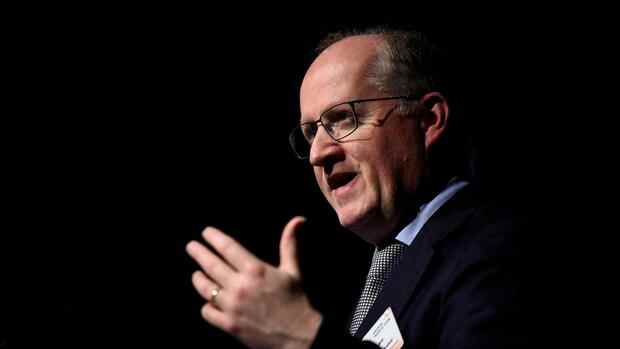Inflation in the euro area recently reached a record level of 9.1 percent.
(Photo: Reuters)
Frankfurt For Priya Misra, investment strategist at US brokerage firm TD Securities, inflation is currently “public enemy number one”. The markets react correspondingly sensitively to any signal that suggests that the central banks will take an even tougher course in the fight against inflation.
On Wednesday, it was Philip Lane who unsettled investors. The chief economist of the European Central Bank signals further rate hikes. The latest 0.75 percentage point hike over the past week was a big step in the move towards interest rate levels that ensure the 2% inflation target is met, Lane said.
“Based on our current view, we anticipate that this transition will require us to raise interest rates further in the next few meetings,” he added. This will slow demand and prevent the risk that inflation expectations will continue to move upwards. Lane is actually considered a dove, i.e. a supporter of a softer monetary policy course.
In July, the ECB initiated the turnaround in interest rates in view of escalating inflation and on Thursday raised the key rates for the second time in a row. In July, it first raised the three main interest rates by 0.50 percentage points each, followed last week by an even larger rate hike of 0.75 percentage points. It was the largest interest rate hike since the introduction of euro cash.
Top jobs of the day
Find the best jobs now and
be notified by email.
Central bank chief Lagarde also signaled further rate hikes. Inflation in the euro area climbed to a new record of 9.1 percent in August.
Lane’s new statements prompted a prompt reaction on the markets. The Dax increased its losses in the afternoon and was 1.2 percent lower at the important mark of 13,000 points. The major indices in the US were basically unchanged in early trading.
As early as Tuesday, US inflation, which was stronger than expected, caused a price slide on Wall Street, which, according to calculations by the information service Bloomberg, destroyed around 1.5 trillion dollars in value in the leading index S&P 500 alone. Reason for the slump: Investors fear an even more restrictive course by the US Federal Reserve.
>> Read here: The Underrated Drama: Why U.S. and Europe Inflation Have Different Reasons
Former US Treasury Secretary Lawrence Summers is asking the Fed to hike rates by a full percentage point at its next meeting next week. At its last two meetings, the Fed had already raised the key rates by an unusually large 75 basis points.
Summers is not alone in his request. According to data from the American index provider CME, the market is now pricing in a full percentage point increase with a 30 percent probability.
Above all, however, the expectations for further interest rate developments in the USA have changed. Although inflation fell to 8.3 percent in August, economists had expected a sharper decline to 8.1 percent.
“The numbers are significant because they are likely to affect the pace of post-September monetary tightening, which will be signaled at next week’s Fed meeting,” said Citi economist Ebrahim Rahbari. In his view, the markets have so far been relatively confident that the Fed would hike interest rates to a level of four percent in the current cycle. But now there is new uncertainty as to where the so-called “terminal rate” lies, i.e. the point up to which the key interest rates will rise.
Citi expects the Fed to raise interest rates by another 0.5 percentage point in November and December. Overall, the bank assumes that they will rise to a level of 4.25 to 4.5 percent.
The bank’s estimates have thus far been above average. After the figures were announced, however, other institutes raised their forecasts. Goldman Sachs now also expects the Fed to hike interest rates by 0.5 percentage points in November and December, after increasing them by 0.75 percentage points in September. It had previously expected an increase of 0.25 percentage points for December.
The chief economist at Goldman Sachs, Jan Hatzius, justified the changed forecast with the fact that inflation in wage-sensitive sectors such as gastronomy, education and care services was high, which suggests that the price pressure will continue for a long time.
More: The Underrated Drama – Why U.S. and Europe Inflation Have Different Reasons


